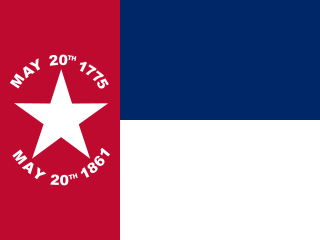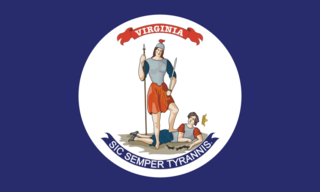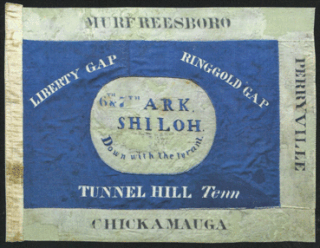
During the American Civil War, the Union Army referred to the United States Army, the land force that fought to preserve the Union of the collective states. Also known as the Federal Army, it proved essential to the preservation of the United States of America as a working, viable republic.

Florida had joined the Confederate States of America in advance of the Civil War, as the third of the original seven states to secede from the Union, following Lincoln's 1860 election. With the smallest population, nearly half of them slaves, Florida only sent 15,000 troops to the Confederate States Army. Its chief importance was in food-supply to the south and support for blockade-runners along its long coastline full of inlets that were hard to patrol.

North Carolina had joined the Confederacy with some reluctance, mainly because neighbouring Virginia had done so, and it remained a divided state throughout the war, with the western mountain people retaining much Union sentiment. Yet it contributed more troops to the Confederacy than any other state, and channelled many vital supplies through the major port of Wilmington, in defiance of the Union blockade.

The Colorado Territory was formally created in 1861 shortly before the bombardment of Fort Sumter sparked the American Civil War. Although sentiments were somewhat divided in the early days of the war, Colorado was only marginally a pro-Union territory. Colorado was strategically important to both the Union and Confederacy because of the gold and silver mines there as both sides wanted to use the mineral wealth to help finance the war. The New Mexico Campaign was a military operation conducted by Confederate Brigadier General Henry Sibley to gain control of the Southwest, including the gold fields of Colorado, the mineral-rich territory of Nevada and the ports of California. The campaign was intended as a prelude to an invasion of the Colorado Territory and an attempt to cut the supply lines between California and the rest of the Union. However, the Confederates were defeated at the Battle of Glorieta Pass in New Mexico and were forced to retreat back to Texas, effectively ending the New Mexico Campaign.
The 9th West Virginia Volunteer Infantry Regiment was an infantry regiment that served in the Union Army during the American Civil War.

During the American Civil War, Arkansas was a Confederate state, though it had initially voted to remain in the Union. Following the capture of Fort Sumter in April 1861, Abraham Lincoln called for troops from every Union state to put down the rebellion, and Arkansas and several other states seceded. For the rest of the war, Arkansas played a major role in controlling the vital Mississippi River and neighboring states, including Tennessee and Missouri.
Galvanized Yankees was a term from the American Civil War denoting former Confederate prisoners of war who swore allegiance to the United States and joined the Union Army. Approximately 5,600 former Confederate soldiers enlisted in the "United States Volunteers", organized into six regiments of infantry between January 1864 and November 1866. Of those, more than 250 had begun their service as Union soldiers, were captured in battle, then enlisted in prison to join a regiment of the Confederate States Army. They surrendered to Union forces in December 1864 and were held by the United States as deserters, but were saved from prosecution by being enlisted in the 5th and 6th U.S. Volunteers. An additional 800 former Confederates served in volunteer regiments raised by the states, forming ten companies. Four of those companies saw combat in the Western Theater against the Confederate Army, two served on the western frontier, and one became an independent company of U.S. Volunteers, serving in Minnesota.

The 1st Arkansas Infantry (1861–1865) was a Confederate Army infantry regiment during the American Civil War. The regiment was raised in April 1861 by Colonel Thompson B. Flournoy. It moved first to Virginia, but transferred back to Tennessee and served the rest of the war in the western theater, seeing action in the Kentucky, Tennessee and Georgia campaigns. Following its depletion in numbers, the regiment was consolidated several times with other Arkansas regiments, finally merging in 1865 into the 1st Arkansas Consolidated Infantry Regiment. There were three regiments known as "1st Arkansas" during the war. The second unit with the designation of "1st Arkansas" was the 1st Infantry, Arkansas State Troops, which was mustered into Confederate service at Pitman's Ferry, Arkansas, on 23 July 1861, under the command of Colonel Patrick Cleburne; this unit was eventually redesignated as the 15th Arkansas Volunteer Infantry. The third unit bearing the title "1st Arkansas" was the 1st Arkansas Volunteer Infantry, which served with the Union Army.

6th Arkansas Infantry Regiment was an infantry formation in the Confederate States Army during the American Civil War. Organized mainly from volunteer companies, including several prewar volunteer militia units, raised in the southern half of Arkansas, the regiment was among the first transferred to Confederate Service. It served virtually the entire war in Confederate forces east of the Mississippi River. After the unit sustained heavy casualties during the Battle of Shiloh and Bragg's Kentucky Campaign, the unit spent most of the rest of the war field consolidated with the 7th Arkansas Infantry Regiment, to form the 6th/7th Arkansas Infantry Regiment.
The Cherokee in the American Civil War were active in the Trans-Mississippi and Western Theaters. In the east, Confederate Cherokees led by William Holland Thomas hindered Union forces trying to use the Appalachian mountain passes of western North Carolina and eastern Tennessee. Out west, Confederate Cherokee Stand Watie led primarily Native Confederate forces in the Indian Territory, in what is now the state of Oklahoma.

22nd Virginia Infantry was a Confederate regiment during the American Civil War. Its commander was George S. Patton, Sr., the grandfather of World War II General George S. Patton.

The 64th Virginia Mounted Infantry Regiment was formed from troops raised in Lee, Scott, Wise and Buchanan counties in Virginia for service in the Confederate States Army during the American Civil War. It served as an infantry regiment, a cavalry regiment, and a mounted infantry (dragoon) unit, and had a mixed reputation.

The 7th Arkansas Volunteer Infantry (1861−1865) was a Confederate Army infantry regiment during the American Civil War composed of troops from northeast Arkansas. Organized mainly from companies, including several prewar volunteer militia companies, raised in northeastern Arkansas, the regiment was among the first transferred to Confederate Service, and spent virtually the entire war serving in Confederate forces east of the Mississippi River. After the unit sustained heavy casualties during the Battle of Shiloh and Bragg's Kentucky Campaign, the unit spent most of the rest of the war field consolidated with the 6th Arkansas Infantry Regiment, to form the 6th/7th Arkansas Infantry Regiment.
The 15th Arkansas Infantry Regiment (Josey's) (1861–1865) was a Confederate Army infantry regiment that served during the American Civil War. The regiment was organized in May 1861 under the command of Colonel Patrick Cleburne. It served throughout the war in the western theater, seeing action in the Kentucky, Tennessee, and Georgia campaigns. Following its depletion in numbers the regiment was consolidated several times with other Arkansas regiments, finally merging in 1865 into the 1st Arkansas Consolidated Infantry Regiment. There were two other regiments which also received the designation of "15th Arkansas". The 21st (McRae's) Arkansas Infantry was redesignated 15th Arkansas in February 1863, but to avoid confusion, was normally referred to as the 15th (Northwest) Arkansas Infantry Regiment. This second "15th Arkansas" was surrendered at Vicksburg in July 1863. A third regiment, under command of Colonels Gee and later Johnson, also received the designation 15th Arkansas Infantry. This last regiment surrendered at Port Hudson, Louisiana, in July 1863.

The 9th Arkansas Infantry was a Confederate Army infantry regiment during the American Civil War. It served throughout the war in the western theater, seeing action in the Vicksburg, Tennessee and Georgia campaigns. Following its depletion in numbers the regiment was consolidated several times with other Arkansas regiments, finally merging in 1865 into the 1st Arkansas Consolidated Mounted Rifles.
The 2nd Arkansas Mounted Rifles (1861–1865) was a Confederate Army infantry regiment that served during the American Civil War. Raised in 1861, the regiment consisted of nine companies, which were drawn from various counties in Arkansas. Throughout the course of the war, the 2nd Arkansas Mounted Rifles fought in a number of battles, including those at Wilson's Creek and Pea Ridge, and participated in a number of campaigns such as Tullahoma, Atlanta and the Carolinas. The regiment's final battle came at Bentonville in March 1865 after which its remaining personnel were consolidated into the 1st Arkansas Consolidated Mounted Rifles.
The 46th United States Colored Infantry was an infantry regiment that served in the Union Army during the American Civil War. The unit was originally designated as the 1st Arkansas Infantry Regiment. The regiment was composed of African American enlisted men commanded by white officers and was authorized by the Bureau of Colored Troops which was created by the United States War Department on May 22, 1863.
The 54th United States Colored Infantry was an infantry regiment that served in the Union Army during the American Civil War. The regiment was composed of African American enlisted men commanded by white officers and was authorized by the Bureau of Colored Troops which was created by the United States War Department on May 22, 1863.
The 61st United States Colored Infantry was an infantry regiment that served in the Union Army during the American Civil War. The regiment was composed of African American enlisted men commanded by white officers and was authorized by the Bureau of Colored Troops which was created by the United States War Department on May 22, 1863. The non-commissioned officers and enlisted men were African Americans. The regiment was originally organized as the 2nd Tennessee Volunteer Infantry and was also referred to as the 2nd West Tennessee Infantry Regiment .














